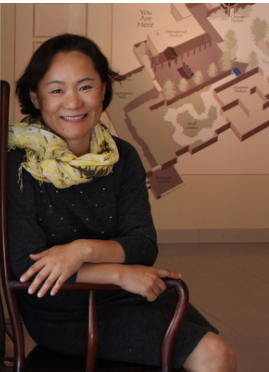“I never thought that I would become an artist or teacher.”
Young Choe has spent more than 20 years volunteering at The National Bonsai & Penjing Museum and working sporadically as a horticulturist at the U.S. National Arboretum. She loves her work, but in her spare time follows what seems to be her true calling of kusamono, the art of curating collections of wild grasses and flowers in unique pots or trays.
Choe fuses her artistic talent with horticulture, resulting in a process she calls “articulture.” Choe says that Kusamono is the perfect tie between her Asian culture, knowledge of plants’ physiology and the talent she has developed toward creating beautiful works. Many kusamono styles exist, but according to Choe, the most developed versions of the art form come from Japan and Europe.
Kusamono can be created in various vessel-like pots or moss balls and can be put on display by itself, on a tray or on a ceramic tile, paired with bonsai as an accent plant.
“It’s a living art form,” says Choe. “Every plant is different depending on how you create it, what kind of plants you put together and which pots you use.”
Choe affirms that kusamono is different than ikebana or bonsai. But, like those practices, each kusamono arrangement requires a unique pruning style that builds a special form over time.
Choe had wanted to study plants since she was young, but horticulture was not a popular subject in her home city of Seoul, South Korea. She ended up studying Asian art in South Korea, but upon moving to America she began volunteering at the National Bonsai & Penjing Museum, an experience that led her back to her old interest in plants.
Soon after, Choe enrolled at the University of Maryland where she received a Bachelor of Science in horticulture. When Choe first started at The National Bonsai & Penjing Museum, the little accent plants that often accompany bonsai arrangements fascinated her. Hoping to learn the art herself, she traveled to Japan three times for a week each time over the course of about five years to study under Keiko Yamane, a kusamono master.
“At that time, I simply learned this because I loved it,” she said. “I never thought that I would become an artist or teacher.”
She now travels around the world instructing on the art of kusamono to other budding practitioners. Most recently, Choe worked on a kusamono arrangement for a reception the Museum held for the American Public Gardens Association’s annual conference.
“When I share this art form, the students are very motivated and happy,” she said. “When I see that kind of energy from people, it makes me happy.”
Choe says that she is grateful to the staff of the U.S. National Arboretum and members of the National Bonsai Foundation for supporting her as a kusamono artist and says she tries to work on kusamono as much as she can when she isn’t working at the Arboretum.
“Kusamono is threatening my main job right now!” Choe joked. “I just keep doing it, I can’t give it up.”






